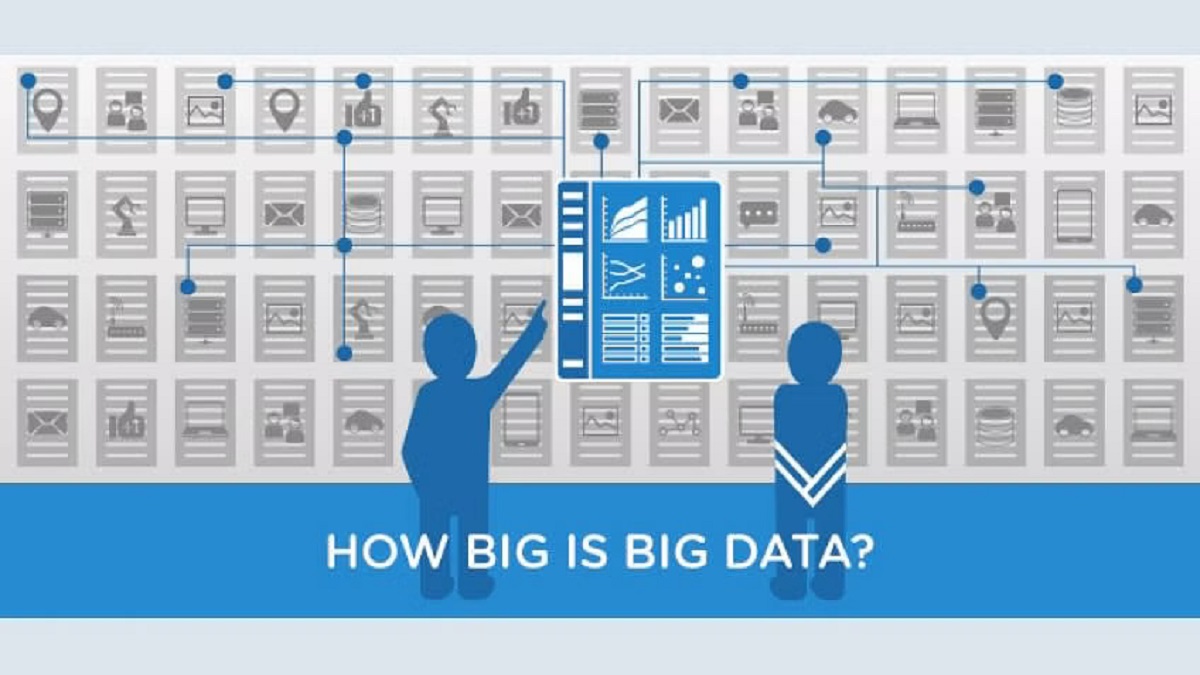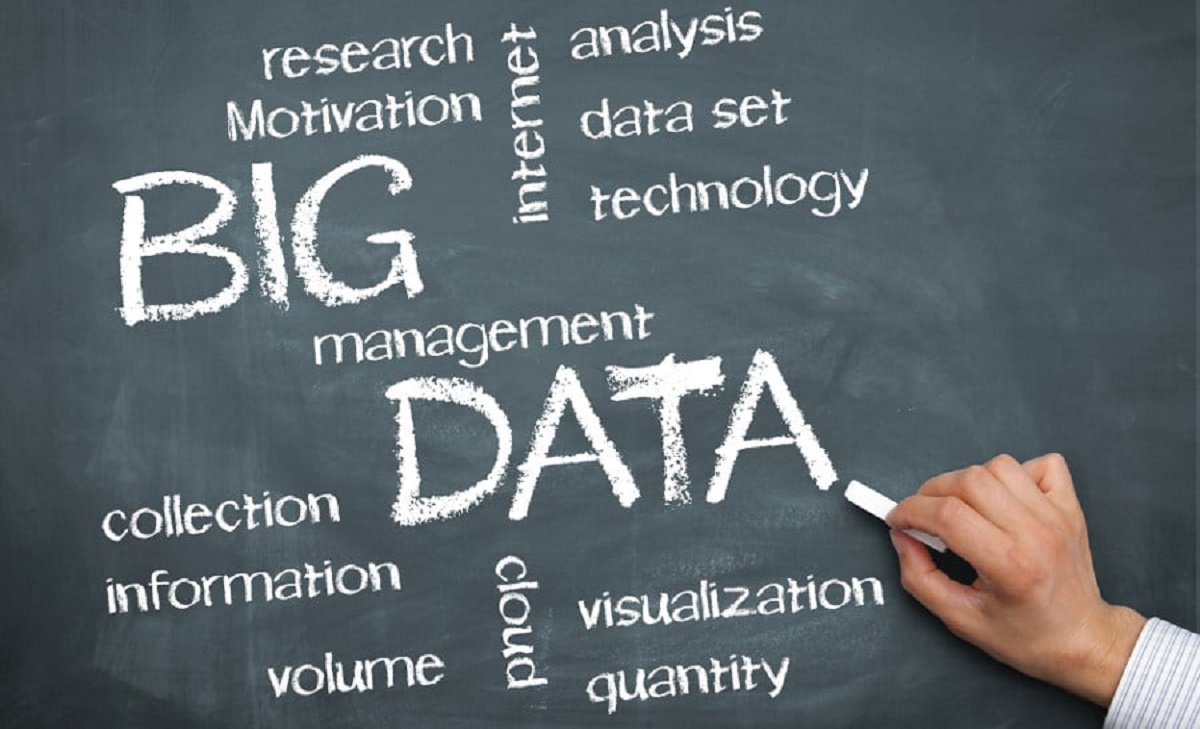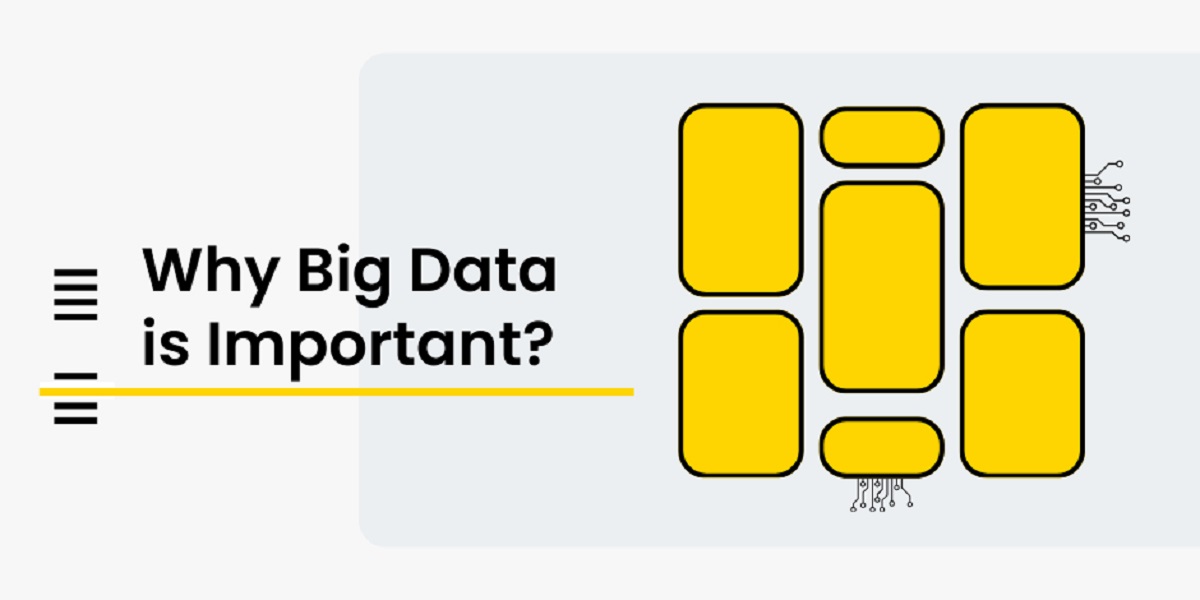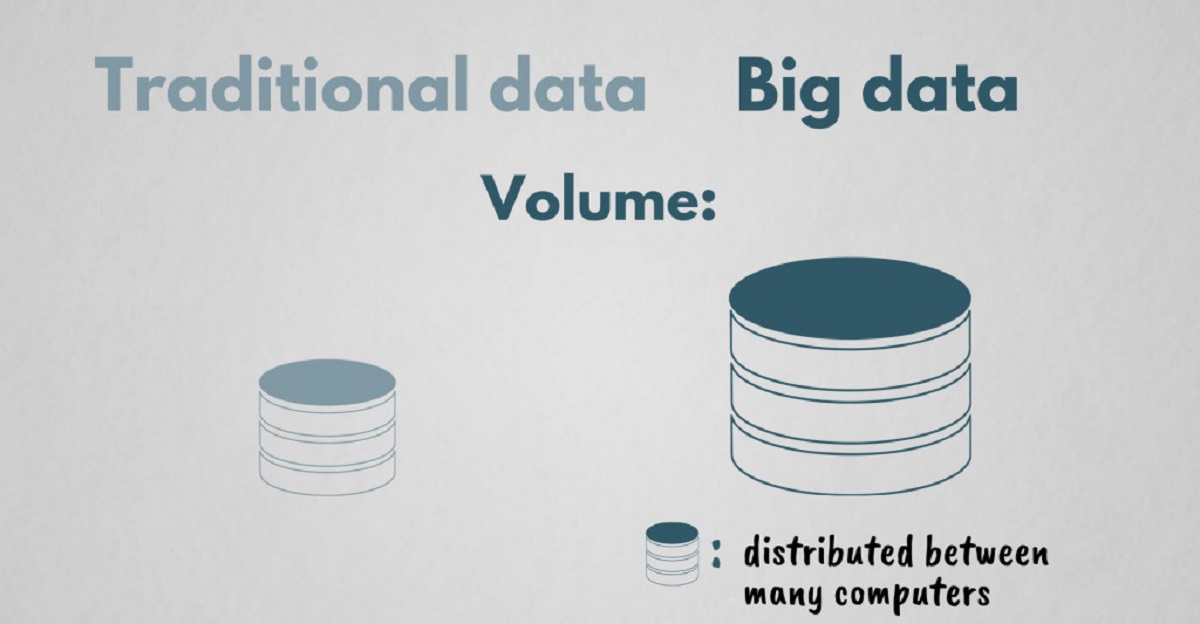What is Big Data?
Big Data refers to large and complex sets of data that are too massive and dynamic to be easily managed, processed, or analyzed by traditional data processing tools. It is characterized by its enormous volume, high velocity, and wide variety of data sources.
The term “Big Data” encompasses both structured and unstructured data, including text, images, videos, social media posts, sensor data, and more. This data is generated from various sources such as social media platforms, business transactions, mobile devices, and IoT devices. The key distinction of Big Data is not just the size, but the wide range of data types and sources.
The main challenge with Big Data is not only its sheer size but also the need to extract valuable insights and patterns from it to make informed decisions. Traditional data processing techniques are often insufficient to handle Big Data, as they were designed for smaller, more structured datasets.
Big Data technologies and analytics tools enable organizations to capture, store, process, and analyze these vast amounts of data in a timely and efficient manner. These technologies include distributed storage systems like Hadoop and cloud-based solutions that provide scalable computing power.
The insights derived from Big Data can provide businesses with a competitive advantage by understanding customer behavior, identifying trends, optimizing operations, and driving innovation. It can help organizations in various sectors, including healthcare, finance, retail, manufacturing, and more, to gain valuable insights from their data to improve decision-making and drive their businesses forward.
In summary, Big Data refers to the large, diverse, and fast-growing datasets that are challenging to process and analyze using traditional methods. It offers immense potential for businesses to gain valuable insights and make data-driven decisions. As we explore the three Vs of Big Data – Volume, Velocity, and Variety – we will dive deeper into the specific characteristics and challenges associated with this field.
The Three Vs of Big Data
The concept of the Three Vs of Big Data provides a framework for understanding the fundamental characteristics of Big Data. These three Vs are Volume, Velocity, and Variety.
1. Volume: Volume refers to the vast amount of data generated and stored. Traditional databases and tools are not designed to handle such large volumes of data. With the exponential growth in data generation, organizations need scalable storage solutions and efficient data management practices to handle the volume of Big Data.
2. Velocity: Velocity represents the speed at which data is generated and processed. Big Data is characterized by real-time or near real-time data streams from various sources like social media, sensors, and IoT devices. Analyzing and deriving insights from streaming data requires powerful data processing and analytics tools capable of handling high velocity.
3. Variety: Variety refers to the diversity of data types and sources in Big Data. Traditional databases are typically designed for structured data, such as numeric or text-based information. However, Big Data comprises unstructured and semi-structured data, including images, videos, audio files, social media posts, and more. Managing and analyzing such diverse data types necessitates advanced data integration and analytics techniques.
These three Vs of Big Data are interrelated and pose significant challenges for organizations. The sheer volume of data requires scalable storage solutions, while the velocity demands real-time processing capabilities. Additionally, the variety of data necessitates sophisticated data integration and analytics approaches.
Moreover, these three Vs continue to evolve as technology advances. Today, the concept of the Three Vs has expanded to include additional dimensions such as Veracity, which assesses the quality, accuracy, and reliability of data, and Value, which focuses on extracting meaningful insights and value from the data.
Understanding and addressing the Three Vs of Big Data is crucial for organizations seeking to leverage the full potential of their data assets. By effectively managing and analyzing large volumes of diverse data in real-time, businesses can gain valuable insights, make informed decisions, and uncover new opportunities for growth and innovation.
Volume: How much data is considered Big Data?
The volume of data that is considered “Big Data” is not defined by a specific size threshold. Instead, what qualifies as Big Data is relative to the capabilities of traditional data processing tools and infrastructure. It refers to datasets that exceed the capability of traditional storage and analysis methods.
While the definition of Big Data is subjective, organizations generally consider data as large if it exceeds terabytes (TB), petabytes (PB), or even exabytes (EB). However, the defining factor is not just the size but the context in which the data is generated and used.
For example, an e-commerce website with millions of daily transactions may consider data as “big” if it surpasses terabytes. On the other hand, a small business with limited operations might still consider data in the gigabyte (GB) range as significant.
It is crucial to recognize that the size of Big Data is not static. As technology advances and data generation escalates, what was once considered Big Data may become the norm. The growing prevalence of IoT devices, social media, and online platforms contributes to the continuous generation of enormous datasets.
With the proliferation of advanced data storage and processing solutions, organizations can now handle and analyze extensive volumes of data more efficiently. Technologies such as distributed file systems, cloud computing, and parallel processing enable scalability and faster data processing.
Moreover, the size of Big Data should also be assessed in conjunction with the other two Vs – velocity and variety. Streaming data generated at a high velocity, regardless of its size, can be considered Big Data due to the challenges associated with real-time processing. Additionally, datasets with heterogeneous data types and sources can pose significant complexities, contributing to the big data landscape.
In summary, the volume of data considered as Big Data varies depending on the context and the capabilities of traditional data processing methods. While terabytes, petabytes, and exabytes are often used as reference points, what truly determines Big Data is its ability to overwhelm traditional storage and analysis approaches. Additionally, the velocity and variety of data also contribute to the size of Big Data, as real-time processing and data integration present further challenges to organizations.
Velocity: How fast is Big Data generated?
The velocity of Big Data refers to the speed at which data is being generated and the need to process it in real-time or near real-time. With the advancement of technology and the increasing number of data sources, data is being generated at an unprecedented rate.
Traditional data processing methods were not designed to handle the velocity at which Big Data is produced. In the past, businesses worked with batch processing, where data was collected and processed periodically. However, with the rise of streaming data sources such as social media, IoT devices, and sensors, real-time analysis of data has become crucial to staying competitive.
Social media platforms alone generate an immense amount of data every second. Twitter, for example, produces around 500 million tweets per day. In the same way, e-commerce websites and mobile applications generate a constant flow of customer data, including clicks, purchases, and interactions, that must be processed promptly to extract real-time insights.
The velocity of Big Data creates challenges in terms of infrastructure, scalability, and processing power. It requires systems that can handle high volumes of data streams, as well as technologies that enable parallel processing and distributed computing.
Organizations have turned to tools and frameworks like Apache Kafka and Apache Flink to handle the high velocity of data. These technologies allow data to be ingested, processed, and analyzed in real-time across distributed systems.
Real-time processing provides businesses with valuable opportunities. For example, it enables immediate detection of anomalies or fraudulent activities, allowing for timely intervention. It also allows companies to deliver personalized experiences to customers, such as real-time recommendations or targeted marketing campaigns.
As the Internet of Things (IoT) continues to expand, the velocity of Big Data will only accelerate further. With billions of connected devices generating data continuously, the need for real-time analytics will become even more critical.
In summary, the velocity of Big Data is determined by the speed at which data is being generated and the requirement for real-time or near real-time processing. The growing number of data sources, such as social media, IoT devices, and sensors, has led to an unprecedented rate of data generation. To handle the velocity of Big Data, organizations need infrastructure, tools, and technologies that enable real-time analysis and insights. Embracing real-time processing opens up opportunities for businesses to gain a competitive edge and deliver personalized experiences to their customers.
Variety: What types of data are part of Big Data?
The variety of data in Big Data refers to the diverse range of data types and sources that organizations encounter in their data sets. Unlike traditional data, which is predominantly structured and organized in a predefined format, Big Data includes both structured, unstructured, and semi-structured data.
Structured data follows a well-defined schema and is stored in databases in a tabular format. Examples of structured data include customer information, inventory records, and transaction data. This type of data is relatively easy to analyze using traditional database techniques and SQL queries.
Unstructured data, on the other hand, lacks a predefined structure and can come in various formats, making it challenging to analyze using traditional methods. Unstructured data includes text documents, emails, social media posts, images, videos, audio files, and more. Extracting insights from unstructured data requires advanced analytics techniques, such as natural language processing (NLP) and machine vision.
Semi-structured data lies between structured and unstructured data. It has some organizational properties but does not strictly adhere to a predefined schema. Examples of semi-structured data include XML files, JSON data, and log files. This type of data requires specific parsing techniques to extract relevant information.
Furthermore, Big Data encompasses data from various sources, including social media platforms, websites, mobile devices, IoT sensors, and more. Social media data includes posts, comments, likes, and shares on platforms like Facebook, Twitter, and Instagram. Web data comprises website logs, user interactions, clickstreams, and online transactions. Mobile data encompasses app usage, location data, and user demographics. IoT sensor data includes readings from smart devices, environmental sensors, and other connected devices.
The variety of data types and sources presents challenges in integrating and analyzing Big Data. Traditional relational databases struggle to handle the variety and volume of diverse data sources. As a result, organizations turn to alternative storage and processing solutions, such as NoSQL databases, distributed file systems like Hadoop, and cloud-based platforms.
By leveraging the variety of data available in Big Data, organizations can gain deeper insights and uncover patterns that were not apparent with structured data alone. Analyzing text data can reveal customer sentiments and opinions, while image and video analysis can provide visual recognition and object detection. The combination of structured, unstructured, and semi-structured data enables a more comprehensive understanding of business operations, customer behavior, and market trends.
In summary, Big Data encompasses structured, unstructured, and semi-structured data from various sources. It includes traditional structured data, unstructured data like text, images, and videos, and semi-structured data like XML and JSON. The variety of data types and sources in Big Data requires advanced analytics techniques and scalable storage and processing solutions. By harnessing the variety of data, organizations can gain valuable insights and uncover hidden patterns to drive innovation and make informed decisions.
Examples of Big Data
Big Data is generated across various industries and sectors, from social media and e-commerce to healthcare and finance. Let’s explore some real-world examples of Big Data and how it is utilized:
Social Media: Social media platforms generate massive amounts of data every minute. For instance, Facebook users share millions of posts, photos, and videos, generating a vast pool of unstructured data. Companies analyze this data to understand customer sentiments, trends, and preferences, enabling targeted marketing campaigns and personalized experiences.
E-commerce: Online retailers continuously gather data on customer behavior, purchase history, and website interactions. This data is used for customer segmentation, personalized product recommendations, and optimizing pricing and inventory management. Amazon, for example, collects vast amounts of data to tailor product suggestions based on individual browsing and purchasing patterns.
Healthcare: Electronic health records and wearable devices generate significant amounts of data in the healthcare industry. Analyzing this data helps identify disease patterns, enable early interventions, and personalize patient care. It also aids in public health initiatives, such as tracking disease outbreaks and monitoring the effectiveness of interventions.
Finance: Financial institutions handle large volumes of data related to transactions, customer profiles, market data, and risk analysis. By analyzing diverse data sources in real-time, they can detect fraudulent activities, uncover market trends, and make data-driven investment decisions.
Transportation: The transportation industry generates substantial amounts of data through GPS systems, traffic sensors, and ticketing transactions. This data is used to optimize logistics, improve route planning, and enhance customer experiences through real-time notifications and personalized services.
Manufacturing: Manufacturing processes generate data from sensors and IoT devices installed in equipment and production lines. This data is analyzed to identify potential bottlenecks, optimize workflows, and predict equipment failures, enabling proactive maintenance and minimizing downtime.
Research and Science: Big Data plays a crucial role in scientific research, such as genomics, particle physics, and climate science. Large-scale experiments generate enormous datasets that require powerful computing and analysis techniques to extract meaningful insights. These insights contribute to advancements in medicine, energy, and environmental sustainability.
These examples demonstrate the wide-reaching impact of Big Data across various industries. They highlight the importance of effectively managing and analyzing large and diverse datasets to gain valuable insights, drive innovation, and make informed decisions.
In today’s data-driven world, organizations that can harness the power of Big Data have a competitive advantage, as they can unlock hidden patterns, discover new opportunities, and enhance customer experiences.
The Challenges of Big Data
While Big Data offers immense potential and valuable insights, it also comes with its fair share of challenges. Here are some of the key challenges organizations face when dealing with Big Data:
Storage Challenges: Big Data, with its large volume, requires robust and scalable storage solutions. Traditional storage systems may not be sufficient to handle the vast amounts of data being generated. Organizations need to invest in distributed storage systems, cloud-based storage, and other scalable technologies to store and retrieve Big Data efficiently.
Processing Challenges: Big Data processing requires significant computational power. Analyzing large datasets in real-time or near real-time can strain traditional processing systems. Parallel processing, distributed computing, and specialized big data processing frameworks like Apache Hadoop and Apache Spark are employed to handle the processing demands of Big Data.
Management Challenges: Managing Big Data involves not only storing and processing it but also ensuring its quality, security, and compliance. The diverse and dynamic nature of Big Data requires effective data governance and management practices. Organizations need to implement measures to protect data privacy, maintain data integrity, and adhere to regulatory requirements like GDPR and HIPAA.
Data Integration Challenges: Big Data is often sourced from a variety of internal and external data sources, each with its own format, structure, and quality. Integrating the different data sources and formats can be complex and time-consuming. Data cleansing, data transformation, and data integration tools and techniques are utilized to ensure consistency and interoperability.
Data Privacy and Security Challenges: With Big Data comes the responsibility to protect sensitive information. Organizations must implement robust security measures to safeguard data against unauthorized access, cyber threats, and breaches. Data anonymization, encryption, access controls, and secure data transmission are crucial in maintaining data privacy and security.
Analytics and Insights Challenges: Extracting meaningful insights from Big Data requires advanced analytics techniques and skilled data scientists. Identifying patterns, correlations, and insights from massive datasets can be complex. Organizations need a combination of data analysis tools, algorithms, and human expertise to derive actionable insights and make data-driven decisions.
Cost Challenges: The infrastructure, storage, and processing requirements of Big Data can be expensive. Investing in the necessary hardware, software, and skilled personnel can put a strain on resources. Managing and optimizing costs while still harnessing the value of Big Data is a challenge that organizations must address.
Addressing these challenges requires a combination of technological advancements, appropriate infrastructure, skilled personnel, and effective data management strategies. Overcoming these obstacles allows organizations to unlock the true value and potential of Big Data and gain a competitive edge in their respective industries.
Storage Challenges: Where to store all the data?
One of the significant challenges posed by Big Data is storing the enormous volume of data generated. Traditional storage systems are often insufficient to handle the scale and complexity of Big Data. Organizations need to identify effective storage solutions that can accommodate large datasets and provide scalability, reliability, and accessibility. Here are some storage challenges faced by organizations dealing with Big Data:
Scalability: The sheer volume of data generated requires storage systems that can scale horizontally to accommodate the increasing data size. Scalable storage solutions ensure that organizations can add storage capacity as needed, without compromising performance or experiencing limitations due to storage constraints.
Distributed Storage Systems: Distributed file systems, such as Apache Hadoop Distributed File System (HDFS), have become popular for storing Big Data. Distributed storage systems divide data across multiple servers or nodes, providing fault tolerance, high availability, and efficient parallel processing. Data is replicated across multiple nodes to ensure data durability and protection against hardware failures.
Cloud Storage: Many organizations are turning to cloud storage solutions for their Big Data needs. Cloud platforms offer virtually unlimited storage capacity and provide the flexibility to scale up or down as per requirements. They eliminate the need for upfront infrastructure investments and allow data to be stored across multiple locations for improved reliability and accessibility.
Object Storage: Object storage is an ideal choice for storing unstructured data in Big Data. In object storage systems, data is stored as objects that are addressed by unique identifiers rather than hierarchical file structures. Object storage provides scalability, high durability, and ease of data retrieval, making it suitable for large-scale data storage and retrieval.
Data Lifecycle Management: Efficient data lifecycle management is crucial for managing the storage of Big Data. Organizations need to define data retention policies and determine which data needs to be stored for immediate analysis, which can be moved to less expensive storage tiers, and which can be archived or deleted altogether. This helps optimize storage costs and ensures that only the relevant data is retained.
Data Compression and Deduplication: To minimize storage requirements, data compression techniques can be applied to reduce the size of data without compromising its integrity. Additionally, deduplication techniques eliminate redundant data, further reducing storage needs. These techniques help optimize storage utilization and improve cost-effectiveness.
Ultimately, choosing the right storage solution for Big Data depends on factors such as data size, frequency of access, performance requirements, security, and cost considerations. Organizations must evaluate their specific requirements and consider a combination of storage technologies, including distributed file systems, cloud storage, object storage, and traditional storage systems, to create a comprehensive storage architecture that meets their needs.
By addressing the storage challenges of Big Data, organizations can ensure efficient data management, accessibility, and scalability. An effective storage strategy is essential for enabling data-driven decision-making, analysis, and deriving valuable insights from Big Data.
Processing Challenges: How to process Big Data efficiently?
Efficiently processing Big Data is a significant challenge due to its size and complexity. Traditional data processing methods are often inadequate to handle the velocity and volume of data generated, resulting in performance bottlenecks. To overcome these challenges, organizations employ various strategies and tools to process Big Data efficiently. Here are some key processing challenges and their respective solutions:
Parallel Processing: Parallel processing is a fundamental technique for dealing with Big Data. It involves dividing the data into smaller subsets and processing them simultaneously on multiple processors or nodes. This technique improves processing speed as it allows for concurrent execution of tasks. Frameworks like Apache Hadoop and Apache Spark leverage parallel processing to enable distributed computing and efficient processing of large datasets.
Distributed Computing: Distributed computing is critical in processing Big Data across multiple nodes or servers. It involves breaking down complex computational tasks into smaller subtasks that can be executed in parallel on different nodes. Distributed computing frameworks ensure efficient resource utilization and provide fault tolerance. Technologies like Apache Hadoop’s MapReduce and Apache Spark’s distributed computing engine facilitate distributed data processing, enabling faster and more efficient analysis of Big Data.
In-Memory Computing: In-memory computing techniques store data in memory rather than on disk, reducing the need for disk I/O operations, which can be a bottleneck in Big Data processing. By keeping data in memory, computational tasks can access and process the data more quickly, improving overall processing speed. Technologies such as Apache Spark’s Resilient Distributed Dataset (RDD) enable in-memory data processing, enhancing the performance of Big Data analytics.
Data Partitioning and Sharding: Partitioning and sharding techniques involve dividing large datasets into smaller, manageable parts based on specific criteria, such as key ranges or geographical regions. Each partition or shard can then be processed independently, reducing the data processed in a single operation. This approach improves performance and allows for distributed processing. Partitioning and sharding strategies are commonly employed in distributed databases and data processing systems.
Data Compression: Data compression techniques reduce the size of data without compromising its integrity. Compressing Big Data can optimize storage utilization and reduce the amount of data transferred during processing. This results in faster data transmission, improved processing speed, and reduced storage costs. Different compression algorithms, such as gzip and Snappy, can be applied to compress data before storage or during data transmissions.
Data Stream Processing: Real-time data processing poses specific challenges due to the streaming nature of the data. Data stream processing technologies, such as Apache Kafka and Apache Flink, enable continuous and real-time analysis of data streams. By processing data in real-time as it arrives, organizations can gain immediate insights, perform real-time monitoring, and make timely decisions based on the latest information.
By leveraging these processing techniques and technologies, organizations can overcome the challenges associated with Big Data processing. Efficiently processing Big Data allows for faster analysis, real-time insights, and better decision-making, providing organizations with a competitive advantage in the ever-evolving data-driven landscape.
Management Challenges: How to maintain and secure Big Data?
Managing and securing Big Data presents unique challenges due to its volume, variety, and velocity. Organizations must implement effective management strategies to ensure data integrity, privacy, and compliance. Here are some key management challenges and their corresponding solutions:
Data Governance: Establishing a robust data governance framework is crucial for managing Big Data. This involves defining data ownership, data stewardship, and data lifecycle processes. A comprehensive data governance strategy ensures that data is effectively managed, protected, and used in a transparent and responsible manner.
Data Quality and Integration: Big Data often comes from diverse sources and may have varying degrees of data quality. Ensuring data quality is essential for accurate analysis and decision-making. Techniques such as data cleansing and normalization are employed to standardize and validate the data. Data integration tools and processes are utilized to merge data from various sources, ensuring consistency and coherence.
Data Privacy and Security: Protecting the privacy and security of Big Data is of utmost importance. Organizations must comply with regulations such as GDPR and HIPAA to safeguard personally identifiable information and sensitive data. Implementing access controls, encryption, and data anonymization techniques ensures that data is protected from unauthorized access and breaches.
Data Access and Permissions: Controlling and managing data access is crucial in maintaining data security and privacy. Role-based access control (RBAC) systems and user permissions are implemented to restrict data access based on user roles and responsibilities. Monitoring and auditing systems track data access, providing visibility into who accessed the data and when.
Data Retention and Archiving: Big Data storage can quickly become cost-prohibitive if all data is retained indefinitely. Establishing data retention policies and archiving strategies is important in managing storage costs and complying with legal requirements. Organizations must determine which data needs to be stored for immediate analysis, which can be moved to lower-cost storage tiers, and which can be archived or deleted altogether.
Data Recovery and Backup: Big Data is susceptible to various risks such as hardware failures, software errors, and natural disasters. Implementing robust data recovery and backup strategies ensures that data remains available and can be restored in the event of a failure. Regular backups, redundant storage, and disaster recovery plans are part of an effective data management strategy.
Data Compliance and Legal Issues: Organizations must comply with legal and regulatory requirements when managing Big Data. This involves understanding and adhering to data protection laws, industry-specific regulations, and contractual obligations. Organizations need to consider data residency, data sovereignty, and international data transfer regulations when storing and processing Big Data.
Data Ethics and Responsible Use: As Big Data becomes more pervasive, ethical considerations surrounding data collection, analysis, and usage are gaining significance. Organizations need to prioritize responsible data practices, transparency, and accountability. Establishing ethical guidelines and ensuring ethical use of data aligns the organization’s practices with societal expectations and fosters trust with customers and stakeholders.
By effectively addressing these management challenges, organizations can maintain the integrity, privacy, and security of Big Data. Implementing robust management strategies ensures that data is handled responsibly, compliant with regulations, and utilized in a manner that delivers value while maintaining trust with customers and stakeholders.
Benefits of Big Data
The utilization of Big Data offers numerous benefits for organizations across various industries. By effectively harnessing the power of large and diverse datasets, organizations can gain valuable insights, make informed decisions, and drive innovation. Here are some key benefits of Big Data:
Personalization: Big Data enables organizations to offer personalized experiences to their customers. By analyzing customer data, businesses can understand individual preferences, behaviors, and needs. This allows for tailored product recommendations, personalized marketing campaigns, and customized customer experiences, leading to higher customer satisfaction and loyalty.
Improved Decision Making: Big Data provides organizations with a wealth of information to inform decision-making processes. By analyzing large and diverse datasets, businesses can gain insights into market trends, customer preferences, and operational efficiency. Data-driven decision making minimizes reliance on guesswork and intuition, leading to more accurate and informed strategic decisions.
Enhanced Customer Service: Big Data enables organizations to provide better customer service. By analyzing customer data in real-time, companies can identify and address potential issues proactively, improving response times and customer satisfaction. Moreover, Big Data analytics can help identify patterns and trends, enabling companies to anticipate customer needs and deliver faster, more personalized support.
Innovation: Big Data serves as a catalyst for innovation by uncovering new insights and opportunities. By analyzing large datasets, organizations can identify emerging trends, customer demands, and gaps in the market. This knowledge allows for the development of innovative products, services, and business models to meet evolving customer needs and stay ahead of the competition.
Operational Efficiency: Big Data analytics can optimize operational efficiency across various business functions. By analyzing data from sensors, machines, and processes, organizations can identify inefficiencies, bottlenecks, and areas for improvement. This knowledge enables process optimization, resource allocation, and predictive maintenance, leading to cost savings, increased productivity, and streamlined operations.
Risk Management: Big Data analytics plays a vital role in risk management. By analyzing vast amounts of data, organizations can identify and mitigate potential risks associated with fraud, cybersecurity threats, and financial irregularities. Real-time monitoring and analysis allow for early detection, prevention, and rapid response to mitigate risks before they cause significant damage.
Market Insights: Big Data analytics provides organizations with valuable market insights. By analyzing customer behavior, competitor data, and market trends, businesses can make data-driven market predictions and understand customer demands. This knowledge allows for the development of targeted marketing strategies, product enhancements, and entry into new market segments.
Scientific Advancements: In scientific research, Big Data drives advancements in various fields. Large-scale datasets enable researchers to gain insights into genomics, climate patterns, particle physics, and other complex scientific phenomena. Analyzing Big Data allows scientists to accelerate discoveries, improve treatments, and drive innovation in fields such as healthcare, energy, and environmental sustainability.
In summary, Big Data offers significant benefits for organizations, enabling personalization, informed decision-making, enhanced customer service, innovation, operational efficiency, risk management, market insights, and scientific advancements. By leveraging the power of Big Data analytics, organizations can unlock valuable insights, drive growth, and gain a competitive advantage in today’s data-driven world.
Personalization: Using Data to Offer Tailored Experiences
Personalization is a key benefit of Big Data, enabling organizations to offer tailored experiences to their customers. By leveraging data analytics and insights, businesses can better understand individual preferences, behaviors, and needs. This allows for customized product recommendations, personalized marketing campaigns, and enhanced customer experiences. Here’s how organizations can harness Big Data to provide personalized experiences:
1. Customer Segmentation: Big Data analytics allows organizations to segment their customer base into distinct groups based on various factors such as demographics, purchasing history, and preferences. This segmentation enables targeted marketing efforts, ensuring that customers receive offers and promotions that are relevant to their specific needs and interests.
2. Product Recommendations: Big Data allows organizations to analyze customer data, including past purchases, browsing history, and clickstream data. With this information, businesses can provide personalized product recommendations in real-time. By understanding individual preferences and behavior patterns, organizations can offer suggestions that match customers’ specific tastes and increase the likelihood of conversion.
3. Dynamic Pricing: Big Data analysis enables dynamic pricing strategies tailored to individual customer behavior. By analyzing real-time market trends, competitor pricing, and customer transaction data, organizations can apply targeted pricing adjustments. This allows businesses to offer personalized discounts, loyalty rewards, and promotions, maximizing customer satisfaction and driving revenue.
4. Personalized Content: Through Big Data analytics, organizations can understand customer preferences for content consumption. By analyzing data on customers’ interests, engagement patterns, and browsing history, businesses can deliver personalized content experiences. This can involve customized recommendations, curated content playlists, and personalized newsfeeds, enhancing customer engagement and loyalty.
5. Customized User Interfaces: Big Data analysis provides insights into how customers interact with digital interfaces. By analyzing user behavior, organizations can personalize user interfaces dynamically. This includes adapting website layouts, mobile app experiences, and user workflows to align with individual preferences and optimize the user experience.
6. Proactive Customer Service: Big Data allows organizations to anticipate customer needs and provide proactive customer service. By analyzing historical customer data and real-time interactions, organizations can detect patterns that indicate potential issues or dissatisfaction. This enables businesses to address customer concerns proactively, resulting in better customer experiences and increased loyalty.
7. Omni-channel Experiences: Big Data enables organizations to deliver consistent and personalized experiences across multiple channels. By integrating data from various touchpoints such as online platforms, mobile apps, and physical stores, organizations can create a seamless and personalized customer journey. This ensures that customers receive relevant and consistent messaging regardless of the channel they engage with.
By leveraging Big Data analytics, organizations can create hyper-personalized experiences that resonate with customers on an individual level. This level of personalization fosters stronger customer relationships, builds brand loyalty, and ultimately drives business growth.
Improved Decision Making: Making Data-Driven Decisions
One of the significant benefits of Big Data is its ability to enable data-driven decision making. By harnessing large and diverse datasets, organizations can gain valuable insights and make informed decisions across various business functions. Here’s how Big Data empowers improved decision making:
1. Enhanced Insights: Big Data analytics provides organizations with deeper and more comprehensive insights into their operations, customers, and markets. By analyzing vast amounts of data from various sources, businesses can uncover patterns, trends, and correlations that were previously hidden. These insights enable a deeper understanding of customer behavior, market dynamics, and operational efficiencies, empowering decision makers to make more informed choices.
2. Real-time Analysis: Big Data allows for real-time or near real-time analysis of data streams. This enables organizations to monitor and respond to changing conditions and trends promptly. Real-time insights allow decision makers to quickly identify emerging opportunities, address potential issues, and adapt strategies in a dynamic and agile manner.
3. Predictive Analytics: Big Data analytics can leverage predictive models to anticipate future outcomes and trends. By analyzing historical data and applying advanced algorithms, organizations can forecast customer behavior, market demand, and industry trends. These predictions provide decision makers with valuable foresight, allowing them to make proactive decisions and mitigate risks.
4. Evidence-Based Decision Making: Big Data provides a solid foundation for evidence-based decision making. Rather than relying solely on intuition and experience, decision makers can leverage data-backed insights to support their decisions. This data-driven approach mitigates biases and subjective judgments, leading to more objective and rational decision making.
5. Improved Strategic Planning: Big Data analytics offers valuable inputs for strategic planning efforts. By analyzing market trends, customer preferences, and competitor landscapes, organizations can develop data-driven strategies that align with business goals. This enables more effective resource allocation, identifying growth opportunities, and staying ahead of market shifts.
6. Risk Mitigation: Big Data analytics helps organizations identify and mitigate business risks. By analyzing vast amounts of data, decision makers can identify potential fraud, cybersecurity threats, and financial irregularities in real-time. This proactive approach to risk management allows businesses to implement appropriate risk mitigation measures and protect their assets.
7. Performance Optimization: Data-driven decision making allows organizations to optimize their performance across various business functions. By analyzing operational data, organizations can identify bottlenecks, inefficiencies, and areas for improvement. With these insights, decision makers can implement targeted actions to enhance productivity, streamline workflows, and reduce costs.
By leveraging Big Data analytics, organizations can unlock a wealth of insights and make data-driven decisions. This approach empowers decision makers to align their strategies, allocate resources effectively, and stay ahead of market shifts. By embracing the power of Big Data, organizations gain a competitive edge and enhance their overall business performance.
Enhanced Customer Service: Delivering Better Customer Experiences
One of the significant benefits of Big Data is its ability to enhance customer service and deliver better customer experiences. By leveraging data analytics and insights, organizations can gain a deeper understanding of their customers, anticipate their needs, and provide personalized support. Here’s how Big Data enables enhanced customer service:
1. Customer Understanding: Big Data analytics allows organizations to analyze vast amounts of customer data to gain insights into their preferences, behaviors, and needs. By understanding customers on a deeper level, businesses can tailor their products, services, and interactions to meet individual expectations, ensuring a more personalized customer experience.
2. Real-time Customer Insights: Big Data enables organizations to gather and analyze real-time customer data, including browsing history, purchase behavior, and social media interactions. By using this data to create customer profiles, organizations can gain instant insights into individual preferences and respond to customer needs in real-time, resulting in more prompt and relevant customer service.
3. Proactive Support: Big Data analytics allows organizations to detect customer issues or concerns proactively. By analyzing customer data, such as usage patterns or product interactions, companies can identify potential points of friction and address them before customers encounter problems. Proactive support reduces customer frustration, enhances satisfaction, and builds loyalty.
4. Personalized Recommendations: Big Data insights enable organizations to provide personalized product and service recommendations to customers. By analyzing customer data, businesses can make accurate suggestions based on individual preferences, previous purchases, and browsing behavior. Personalized recommendations enhance the customer experience by offering relevant options and saving customers time and effort in finding what they need.
5. Omni-channel Experience: Big Data enables organizations to deliver a consistent and seamless experience across multiple channels. By analyzing customer data from various touchpoints such as websites, mobile apps, and physical stores, organizations can provide unified customer experiences. This ensures that customers receive consistent messaging and service, regardless of the channel they choose to interact with.
6. Predictive Service: Big Data analytics can enable predictive service capabilities. By identifying patterns and trends in customer behavior, organizations can anticipate customer needs and proactively offer support and assistance. Predictive service enhances the customer experience by addressing potential issues before they arise and exceeding customer expectations.
7. Customer Feedback Analysis: Big Data analytics allows organizations to analyze customer feedback from various sources, such as online reviews, social media, and customer surveys. By extracting insights from this feedback, organizations can identify areas for improvement, address customer concerns, and make informed decisions to enhance the overall customer experience.
By leveraging Big Data analytics, organizations can improve their customer service capabilities and deliver better customer experiences. Personalization, real-time insights, proactive support, and predictive service empower organizations to meet customer needs, foster loyalty, and drive business growth.
Innovation: Discovering New Insights and Opportunities
Big Data plays a crucial role in driving innovation by unlocking new insights, revealing hidden patterns, and uncovering opportunities for organizations. By leveraging advanced analytics and processing techniques, companies can make data-driven discoveries that lead to innovation. Here’s how Big Data fuels innovation:
1. Uncovering Hidden Patterns: Big Data analytics allows organizations to analyze vast and diverse datasets to uncover hidden patterns and correlations. By analyzing large volumes of data from multiple sources, organizations can identify trends, relationships, and anomalies that were previously unknown. These observations provide valuable insights that can lead to innovative ideas, improved processes, and new solutions.
2. Identifying Market Trends: Big Data analysis helps organizations gain a deeper understanding of market trends and emerging opportunities. By analyzing customer behavior, competitor data, and industry trends, companies can identify shifts in consumer demands, market gaps, and emerging niches. This understanding allows organizations to develop innovative products, services, and business models that cater to changing market needs.
3. Enhanced Research and Development: Big Data empowers research and development efforts by providing a wealth of data for analysis. Scientists and researchers can leverage Big Data to gain insights into complex scientific phenomena, conduct simulations, and perform data-driven experiments. These capabilities accelerate discoveries, drive innovation, and advance fields such as medicine, energy, and environmental sustainability.
4. Data-Driven Decision Making: Big Data analytics enables data-driven decision making, which is essential for innovation. By analyzing large datasets, organizations can make informed decisions based on empirical evidence rather than relying solely on intuition or gut feelings. Data-driven decision making helps mitigate risks, optimize processes, and identify innovative strategies that drive growth.
5. Improving Product Development: Big Data offers valuable insights for product development and enhancement. By analyzing data on customer preferences, usage patterns, and feedback, organizations can identify areas for improvement, develop customer-centric features, and create innovative product offerings. Big Data allows organizations to iterate products based on real-time market feedback, leading to more refined and successful product launches.
6. Enhancing Customer Experiences: Big Data can significantly impact customer experiences, leading to innovation in service delivery. By leveraging customer data, organizations can personalize interactions, tailor offerings, and provide relevant recommendations. This level of personalization enhances customer satisfaction, fosters loyalty, and drives innovation in customer-centric strategies and approaches.
7. Driving Operational Efficiency: Big Data analytics helps identify inefficiencies and bottlenecks in operations. By analyzing operational data, organizations can uncover opportunities for process optimization, cost reduction, and performance improvement. These insights lead to innovation in operational practices, supply chain management, and resource utilization.
Big Data enables organizations to discover new insights, uncover market trends, and drive innovative strategies. By leveraging the power of Big Data analytics, organizations can gain a competitive edge, foster innovation, and embrace data-driven approaches that propel them forward in an ever-changing business landscape.
Conclusion
In conclusion, Big Data presents both challenges and benefits for organizations across various industries. With its immense volumes, high velocities, and diverse varieties, Big Data requires robust storage, efficient processing, and effective management strategies. However, when harnessed successfully, Big Data offers significant advantages.
The benefits of Big Data are evident in various areas. Personalization allows organizations to deliver tailored experiences, enhancing customer satisfaction and loyalty. Data-driven decision making enables organizations to make informed choices, optimizing operations, and improving strategic planning. Enhanced customer service, fueled by Big Data insights, leads to better customer experiences and increased engagement.
Big Data also promotes innovation by uncovering hidden insights, identifying emerging trends, and driving research and development efforts. Organizations can leverage Big Data to gain market intelligence and yield new opportunities. Furthermore, Big Data plays a pivotal role in risk management, allowing organizations to proactively detect and mitigate threats.
To harness the power of Big Data, organizations must invest in scalable storage solutions, parallel processing technologies, and data governance practices. They must also prioritize data quality, privacy, and security. Leveraging advanced analytics techniques, such as machine learning and predictive modeling, enables organizations to derive meaningful insights and drive innovation.
As Big Data continues to evolve and grow, organizations that effectively utilize its power gain a competitive advantage. By understanding and addressing the challenges of Big Data while leveraging its benefits, organizations can unlock the full potential of their data assets, make data-driven decisions, and drive sustainable growth in a data-centric world.

























